
This photograph shows a backpacker on the Appalachian Trail in the White Mountains of New Hampshire. The USGS is studying trail and camping conditions to inform camping management and help improve trail sustainability. (Credit: Jeffrey Marion, USGS. Public domain.)
It’s Great Outdoors Month! As the weather warms up and more people head out to explore the outdoors, the U.S. Geological Survey has tips for minimizing impacts to the environment. Leaving no trace can be a challenge and sometimes a small act can have a large impact.
Land managers are faced with protecting the environment while supporting recreational opportunities including camping, hiking, ATV riding, fishing, and wildlife viewing. These activities can lead to negative impacts such as trampled vegetation, soil erosion, water contamination, tree cutting, and displacement of wildlife from their habitat.
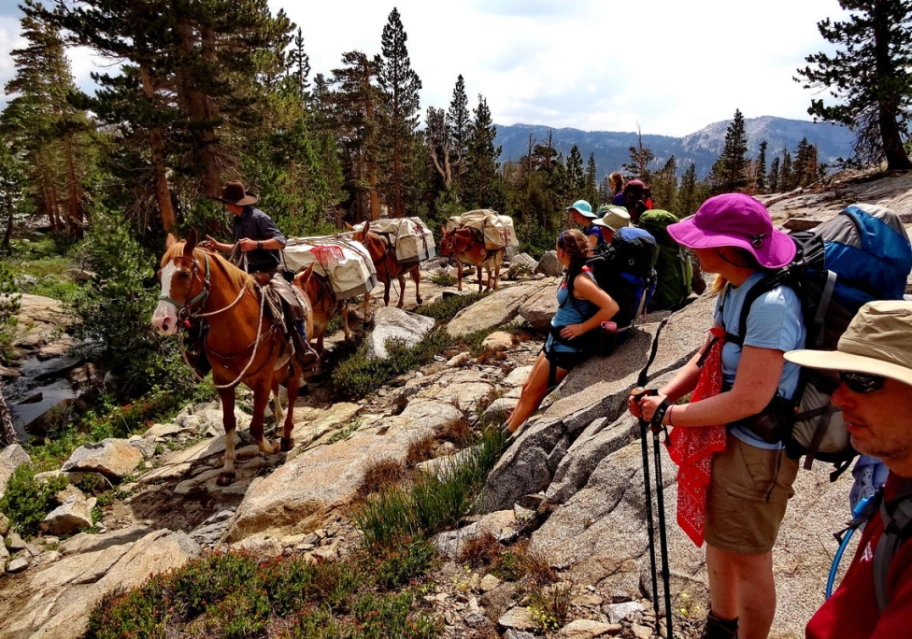
USGS research is investigating factors that affect the sustainability of trails to support heavy hiking and horse traffic like in this scene taken along the Pacific Crest Trail in Yosemite National Park in California. Photograph taken in 2013. (Credit: Jeffrey Marion, USGS. Public domain.)
“USGS scientists are studying how visitors are impacting protected natural areas and providing recommendations for land managers as they develop mitigation strategies,” said Jeff Marion, a USGS research ecologist. “By using sound science, the most effective decisions can be made to preserve the nation’s parks, forests, and wilderness and allow everyone to enjoy these treasured landscapes.”
Some science-based tips include:
- Leaving plants as found
- Observing wildlife from a distance
- Not feeding wildlife
- Properly containing and removing trash
- Selecting established campsites
- Gathering small diameter dead and fallen wood for fires instead of cutting down trees
- Using designated hiking trails
- Land managers communicating low-impact practices to visitors as an effective educational strategy
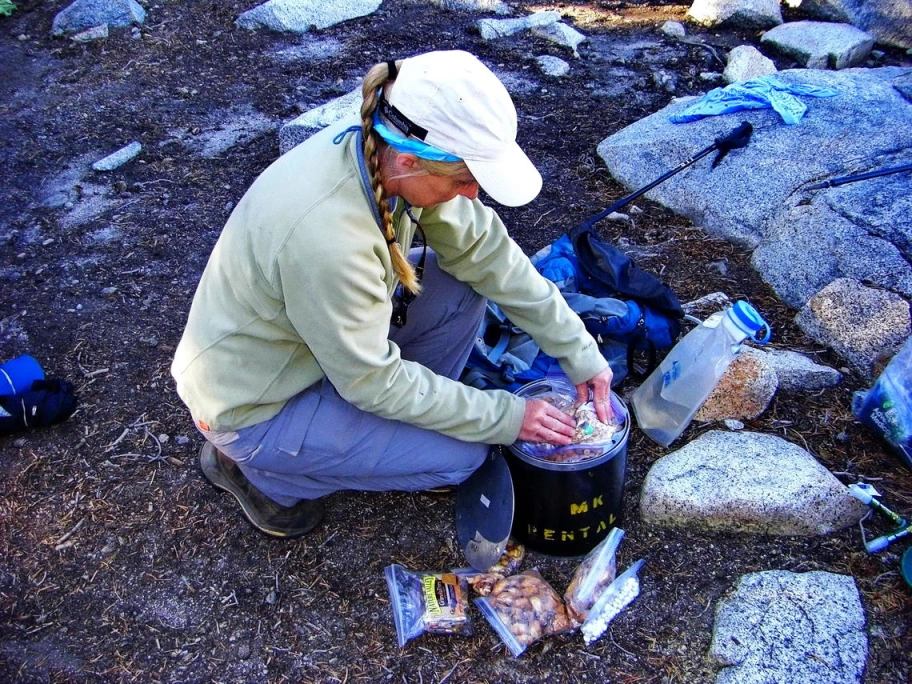
A backpacker storing all food, trash, and smellables in a bear-proof storage canister in Yosemite National Park in California. (Credit: Jeffrey Marion, USGS. Public domain.)
Protecting Wildlife and Their Habitat
The USGS has outlined several actions to avoid or minimize visitor impacts to wildlife and their habitats. This includes encouraging visitors to take photos but leave plants and wildlife as found, observing wildlife from a distance with binoculars, stopping if wildlife reacts to a person’s presence, and practicing quiet behaviors. Pets should be left at home or kept on a leash. USGS science also helps with the design of parks, such as the suggestion to use boardwalks with railings and platforms for wildlife viewing.
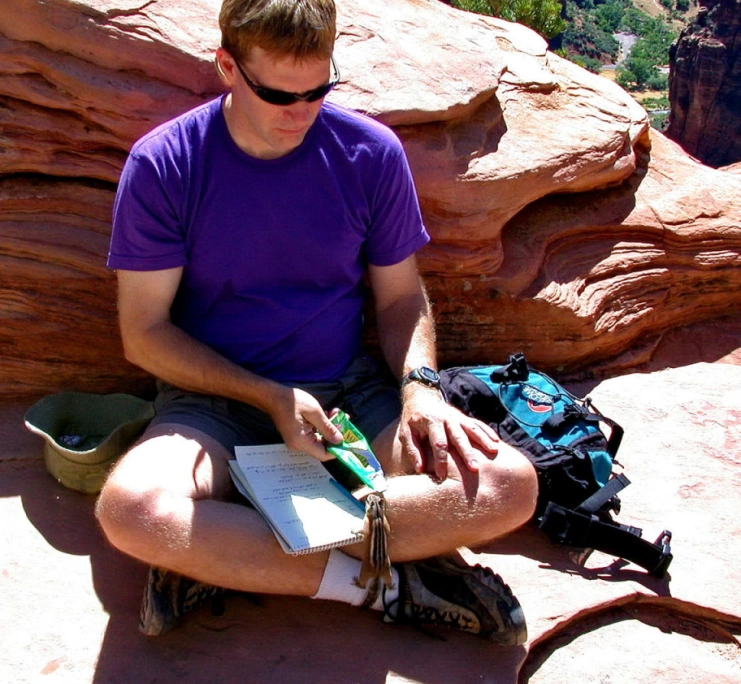
USGS research investigated the effectiveness of certain actions designed to deter visitors in Zion National Park in Utah from feeding wildlife. USGS scientist Jeffrey Marion is photographed while assessing the strength of food attraction behavior among chipmunks. (Credit: Robert Manning, University of Vermont.)
Avoid Feeding Wildlife
USGS scientists recommend to never feed wildlife. All food, trash, and smellable items should be stored, and waste should be disposed of properly.
Feeding wildlife can result in food attraction behavior, where animals start to associate people with food, sometimes putting dangerous animals or those that spread disease near humans. The practice is also harmful to wildlife, as they can suffer nutritionally, depend on unreliable food sources and become more susceptible to predators, dogs, and vehicle accidents.
As an example, USGS scientists helped develop successful communication strategies at the popular Angel’s Landing Trail at Zion National Park in Utah to deter wildlife feeding. Educational messages were provided through signs or delivered personally by uniformed park staff.

This side-hill campsite concentrates camping on a small area of disturbance. The site is in the Annapolis Rocks camping area along the Appalachian Trail in Maryland. (Credit: Jeffrey Marion, USGS. Public domain.)
Designing and Selecting Campsites
To minimize environmental impacts when camping, USGS scientists recommend using a limited number of well-established or designated camping sites. Another option is to select an area out of sight or distant from trails, water, and existing campsites. The site should also have a durable surface, including rock, gravel, snow, dry and grassy areas and places with little to no vegetation, such as sandy shorelines.
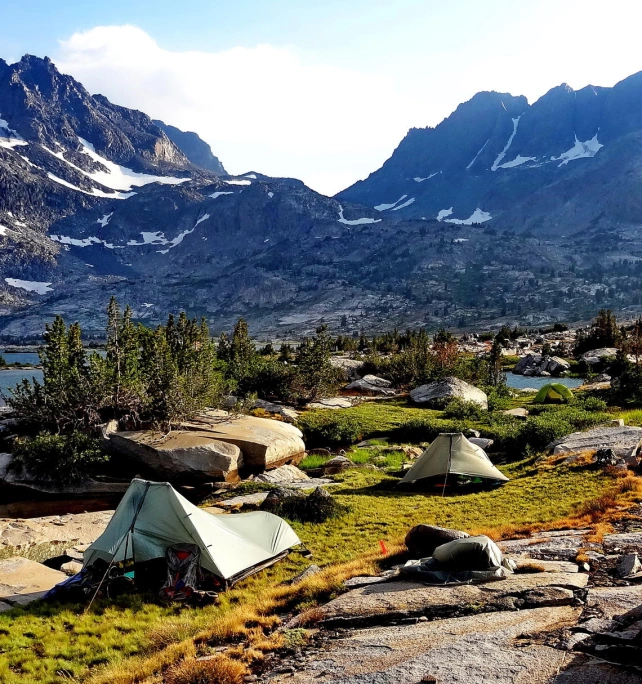
Pristine campsite at Thousand Island Lake along the Pacific Crest Trail in California. (Credit: Jeffrey Marion, USGS. Public domain.)
Campsites on sloped terrain with sufficient flat areas for tents should also be considered. Campsites in large, flat areas are frequently expanded by campers, which can cause more water runoff with soil and pollutants into lakes and creeks. This can degrade aquatic environments, leading to impacts such as decreased water clarity and purity.
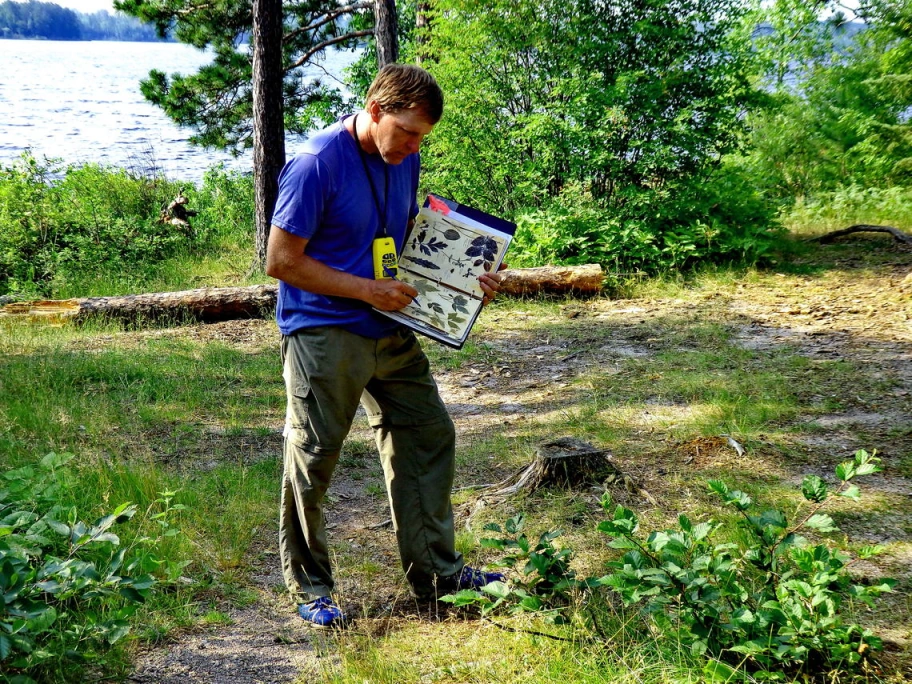
USGS scientist Jeffrey Marion assessing campsite conditions at the Boundary Waters Canoe Area Wilderness in northern Minnesota. (Credit: Holly Eagleston, Virginia Tech Graduate Student, College of Natural Resources and the Environment.)
The USGS was involved in a recent study on the Appalachian National Scenic Trail that highlights the importance of considering campsite location and terrain to enhance sustainability. The USGS is also conducting research along the Pacific Crest Trail to identify the most sustainable campsites and develop online maps for easy navigation to those locations.
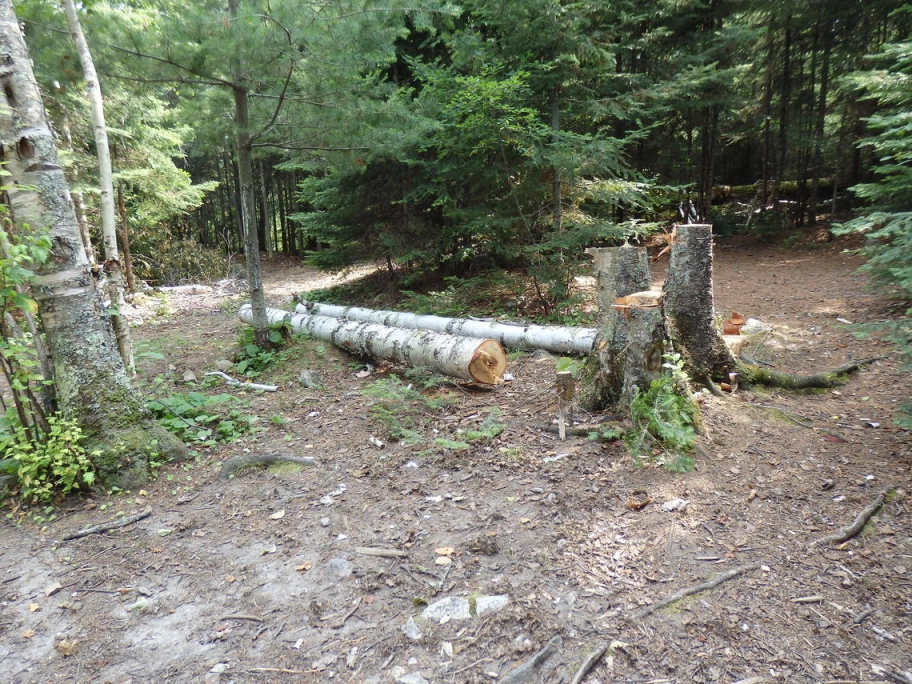
Trees cut down for firewood in the Boundary Waters Canoe Area Wilderness in northern Minnesota. (Credit: Jeffrey Marion, USGS. Public domain.)
Cutting Down Trees for Firewood
Another issue associated with camping is cutting down trees for firewood. A USGS study of campsites in the Boundary Waters Canoe Area Wilderness of northern Minnesota found that 44% of campsite trees had been damaged and approximately 18 trees per campsite had been cut down, primarily for firewood. With 2,000 campsites in Boundary Waters, that’s approximately 36,000 tree stumps in a single wilderness area. This significantly alters natural environments, especially wildlife habitats.
USGS research recommends that land managers consider enhancing existing low-impact educational messaging on gathering small diameter dead and fallen firewood and urging or requiring visitors to leave tools used to cut down trees at home.
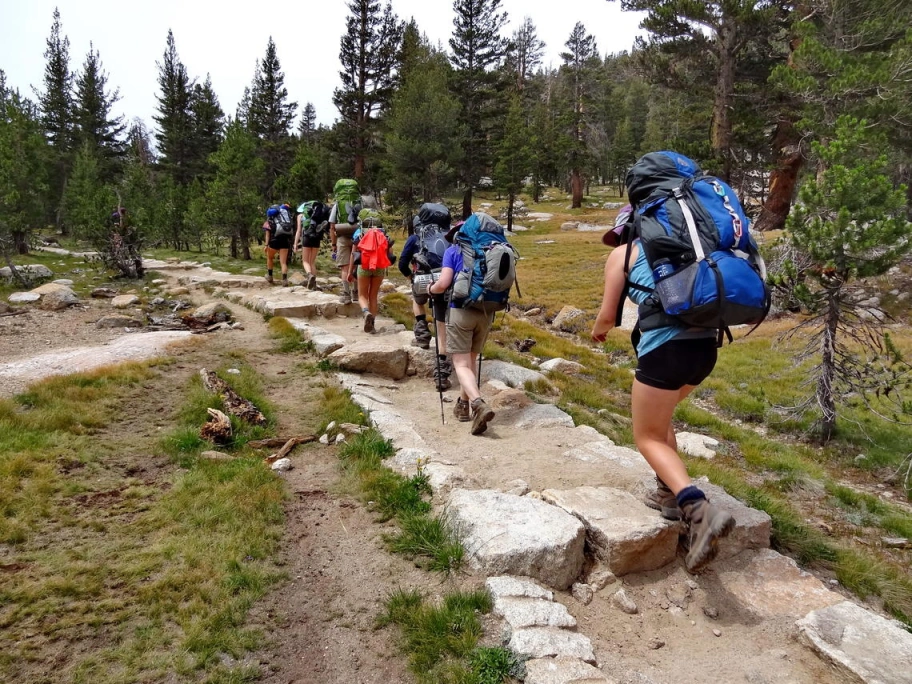
Backpackers hiking the Pacific Crest Trail in Yosemite National Park in California. Impacts to plants and soils can be seen to the left where previous hikers did not stay on the formal trail. (Credit: Jeffrey Marion, USGS. Public domain.)
Hiking Trails
Even on designated trails, hiking traffic and use by mountain bikers, motorized vehicles and horseback riders all take their toll. More visitors have been venturing off trails, trampling and removing protective vegetation and organic materials. This can lead to soil loss and increased water runoff and erosion.
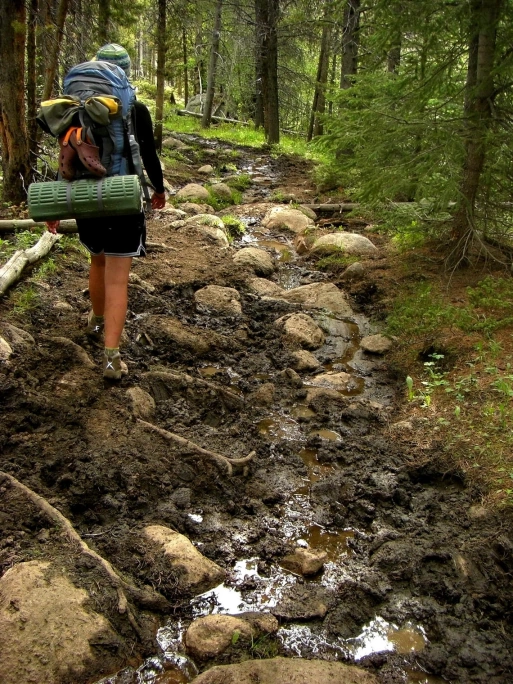
A backpacker hiking a wet muddy trail in the Wind River Mountains of Wyoming in the Bridger Wilderness, Bridger-Teton National Forest. (Credit: Jeffrey Marion, USGS. Public domain.)
To address this issue, USGS scientists and partners are studying sustainable trail design. For example, the USGS was involved in a recent study on the layout of trails along the Appalachian Trail. Scientists find that trails with side-slopes are preferred as they allow for water drainage, while trails in flatter terrain are more likely to result in muddiness, widening and soil loss.
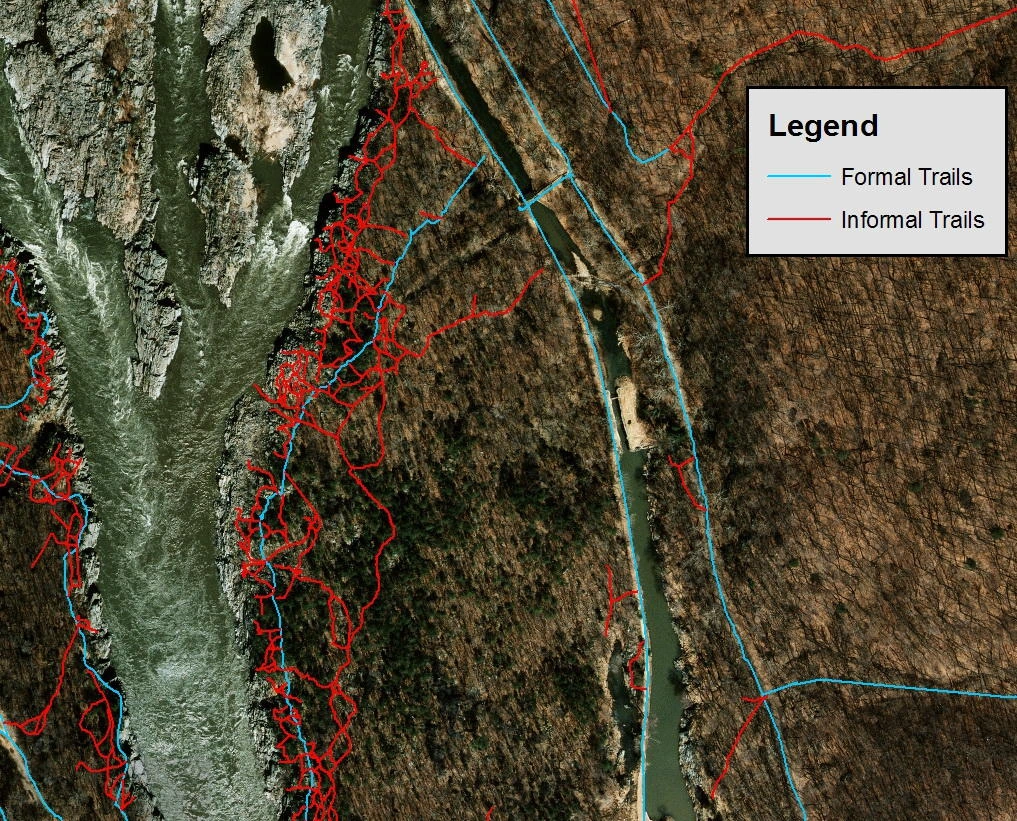
USGS research documented these informal trails created by off-trail visitor traffic in areas with large numbers of rare and endangered plants in Potomac Gorge near Washington, DC. (Credit: Jeffrey Marion, USGS. Public domain.)
Researchers are also working to determine which actions best deter off-trail hiking, ranging from educational signs to low fencing near trail borders. As examples, the USGS helped with research to protect large numbers of rare plants near the Billy Goat Trail in Washington, D.C., and address the trampling of soils and vegetation at Cadillac Mountain at Acadia National Park in Maine.

USGS scientist Jeffrey Marion and Virginia Tech student Holly Eagleston measuring conditions at the Appalachian Trail in Virginia to evaluate trail impacts and sustainability guidance. Photograph taken in 2014. (Credit: Matthew Browning, Virginia Tech Graduate Student, College of Natural Resources and the Environment.)
Value of USGS Science
The USGS was part of a recent evaluation on the effectiveness of educating visitors as opposed to setting regulations. Research found that several impacts can be reduced and conditions improved when low-impact practices are communicated to visitors.
USGS science is used by many organizations to develop and communicate low-impact outdoor practices. This includes the Leave No Trace Center for Outdoor Ethics and federal land management agencies, such as the National Park Service, Bureau of Land Management, U.S. Fish and Wildlife Service, U.S. Forest Service and the U.S. Army Corps of Engineers.
More Information
Learn more about USGS science on leaving no trace in the outdoors: https://www.usgs.gov/centers/





{ 0 comments… add one now }